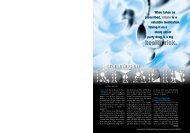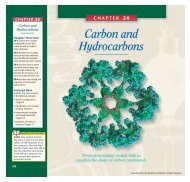You also want an ePaper? Increase the reach of your titles
YUMPU automatically turns print PDFs into web optimized ePapers that Google loves.
SECTION 9-2<br />
STOP<br />
326<br />
Misconception<br />
Alert<br />
Students may confuse the pressure<br />
increase in Pascal’s principle <strong>with</strong><br />
the pressure of the fluid itself.<br />
While an increase in pressure is<br />
transmitted equally throughout a<br />
fluid, the total pressure at different<br />
points in the fluid may vary, for<br />
example, <strong>with</strong> depth.<br />
Each time you squeeze a tube of<br />
toothpaste, you experience Pascal’s<br />
principle in action.The pressure you<br />
apply by squeezing the sides of the<br />
tube is transmitted throughout the<br />
toothpaste.The increased pressure<br />
near the open mouth of the tube<br />
forces the paste out and onto your<br />
toothbrush.<br />
Figure 9-7<br />
Because the pressure is the same<br />
on both sides of the enclosed fluid<br />
in a hydraulic lift, a small force on<br />
the smaller piston (left) produces<br />
a much larger force on the larger<br />
piston (right).<br />
326<br />
Chapter 9<br />
Applied pressure is transmitted equally throughout a fluid<br />
When you pump a bicycle tire, you apply a force on the pump that in turn<br />
exerts a force on the air inside the tire. The air responds by pushing not only<br />
against the pump but also against the walls of the tire. As a result, the pressure<br />
increases by an equal amount throughout the tire.<br />
In general, if the pressure in a fluid is increased at any point in a container<br />
(such as at the valve of the tire), the pressure increases at all points inside the<br />
container by exactly the same amount. Blaise Pascal (1623–1662) noted this<br />
fact in what is now called Pascal’s principle (or Pascal’s law):<br />
PASCAL’S PRINCIPLE<br />
Pressure applied to a fluid in a closed container is transmitted<br />
equally to every point of the fluid and to the walls of the container.<br />
A hydraulic lift, such as the one shown in Figure 9-7, makes use of Pascal’s<br />
principle. A small force F 1 applied to a small piston of area A 1 causes a pressure<br />
increase in a fluid, such as oil. According to Pascal’s law, this increase in pressure,<br />
P inc, is transmitted to a larger piston of area A 2 and the fluid exerts a force<br />
F 2 on this piston. Applying Pascal’s principle and the definition of pressure<br />
gives the following equation:<br />
F 1<br />
A 1<br />
F1 F2 Pinc = ⎯⎯ = ⎯⎯ A1<br />
A2<br />
Rearranging this equation to solve for F 2 produces the following:<br />
F2 = ⎯ A2<br />
⎯F1 A1<br />
This second equation shows that the output force, F 2, is larger than the<br />
input force, F 1, by a factor equal to the ratio of the areas of the two pistons.<br />
F 2<br />
A 2<br />
Copyright © by Holt, Rinehart and Winston. All rights reserved.
















